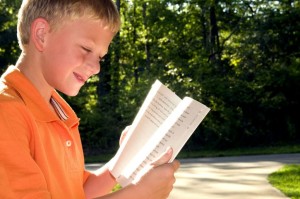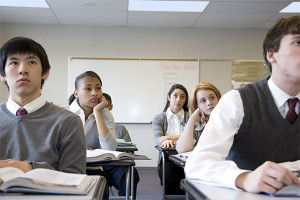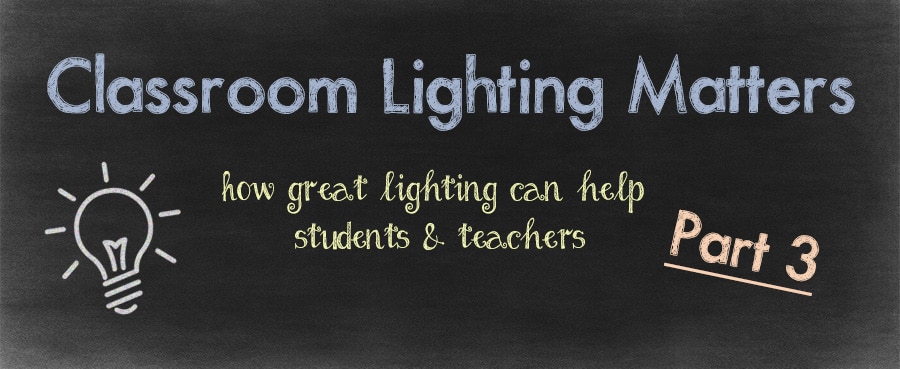Reading comprehension and agility are two of the most important factors in our children’s lives. Most standardized tests have an entire section dedicated to this idea, yet one of the simplest solutions to raising test scores, classroom lighting, has been overlooked for years.
So, is it true? Does brightness and color of light really affect reading performance?
In the first post of our Classroom Lighting Matters series, we discussed a study by Liebel et al., which explored many related ideas, such as how pupil size is affected by spectrum and light level, and how reading is affected by pupil size. By connecting these two ideas, we can see that reading speed is affected by both spectrum and light level.
In the second post, we discovered how exposure to natural daylight early in the morning helps students prepare for a day of activity and stress.
In the third and final post of our Classroom Lighting Matters series, we’ll take a deeper look into Liebel’s study to show how spectrum and light levels affect reading speed.
Conditions of the study mimicked classroom lighting
The backdrop for the study was in a simulated office environment. Not only did the lighting mimic a typical modern facility, but so did the size of the text.
For this study, lighting was 200-500 lux horizontal, and print size was 6-12 point type. The participants 18-49 years old, and they were divided into three groups with a roughly equal amount of males and females in each group.
Each person was tested at three light levels: twice under an 830 lamp and twice under an 865 lamp, for a total of 12 separate lighting combinations.
Does blue spectrum classroom lighting improve reading speed?
 To measure light spectrum color, we use a scale called Color Correlated Spectrum (CCT). The study showed under a fixed spectrum, an increase in the lighting level decreases the size of the pupil. Similarly, under a fixed luminance, a higher CCT (blue light) also decreases the size of the pupil.
To measure light spectrum color, we use a scale called Color Correlated Spectrum (CCT). The study showed under a fixed spectrum, an increase in the lighting level decreases the size of the pupil. Similarly, under a fixed luminance, a higher CCT (blue light) also decreases the size of the pupil.
- Fixed spectrum + Increased lighting levels = Smaller pupils
- Fixed luminance + higher CCT, or blue light = Smaller pupils
This means spectrum lighting and light level affect reading speed and accuracy. So it’s an even trade-off:
A higher CCT lamp can improve reading performance at a lower light level, while a lower CCT lamp provides equal reading performance at a moderate light level, or lighting typical of interior office spaces.
Note: Because of this, it is possible to save lighting energy by simply replacing a current high-energy lighting source with one having more bluish spectral content, i.e., a higher CCT at a lower lighting level. The US Department of Energy has more information on saving energy costs.
We can conclude a definite correlation exists between pupil size and reading performance. While spectrum, lighting levels and lighting distribution are involved, research shows that spectrum plays a larger role.
Student Performance

Several studies have been conducted on higher blue spectrum light in the classroom and student achievement. The process of introducing more natural light in schools has commonly been referred to as “daylighting.” The following are findings compiled from Healthyschools.org:
- Students in Capistrano School District in Orange County, CA who had more daylighting in their classrooms progressed 20 percent faster on math tests and 26 percent faster on reading tests in one year than students with the a lesser amount of daylighting.
- The Poudre School District in Fort Collins, CO found a 7 percent improvement in test scores in classrooms that used daylighting and a 14-18 percent improvement for students in classrooms with the largest window areas.
- In Seattle, WA students in classrooms with the most access to daylight were found to test 9-15 percent higher than students in classrooms with the least window area.
Resources
For more information regarding full spectrum lighting for the classroom and how it can improve the learning environment in regard to reading speed and accuracy, please visit our resource center.
Citations
Liebel, Brian, Sam Berman, Robert Clear, Rita Lee, and Marc Fountain. “Reading Speed and Accuracy Are Affected by Lighting Level.” Walalight. N.p., 26 Mar. 2014. Web.

For my science fair project we tried this test and our answers differ. Our results showed that the dimmest light setting we could find without the lights being completely off work the best.
Hi Stephanie –
Were you judging the color of the light as well as the brightness? Also, what measurement criteria where you using in the experiment. Would love to know more!